Italian version of casting on loops used for knitting cuffs, necks, elastic bands of warm clothes. Such elements of clothing retain elasticity, beauty and a given geometric shape, even after a large number of washes. The pattern of Italian elastic with knitting needles is suitable for both experienced knitters and beginners.
Italian method of casting on stitches. Diagram and description:
This method allows you to create beautiful patterns. They use 2 basic knitting techniques. Italian elastic with knitting needles - a pattern with an additional thread or a version without it. The first method is more difficult, but more interesting. They work with three knitting needles. When creating cuffs and the bottom edge of knitted products, they use special elastic yarn of a contrasting color. Casting on loops without an additional thread is quick and easy.
This technique is easier for practical implementation by inexperienced knitters. The work is done with one knitting needle. Work with a metal or wooden tool 1 mm thinner than the yarn used.
The following steps are performed sequentially:
- The 1st loop is formed in the classic way.
- The total number of loops is calculated. If there is an even number, the last element of the strip is knitted. If there is an odd number, the outer loop is knitted purlwise.
- In the 2nd chain, the first element is formed using the front method. It is important to correctly arrange the threads and determine their numbering. It is more convenient to consider the first one as the one held by the thumb, and the second one as the one directed by the index finger. This will avoid confusion when implementing the scheme and speed up the process of forming the Italian elastic.
- The needle is inserted under the first thread, simultaneously picking up the second one, which is pulled from the index finger. The loop formed as a result of these manipulations is pulled through and fixed on the needle.
- Then knit the purl element. Insert the needle under the 2nd thread and pick up the first.
- Loops are collected until the required number is reached.
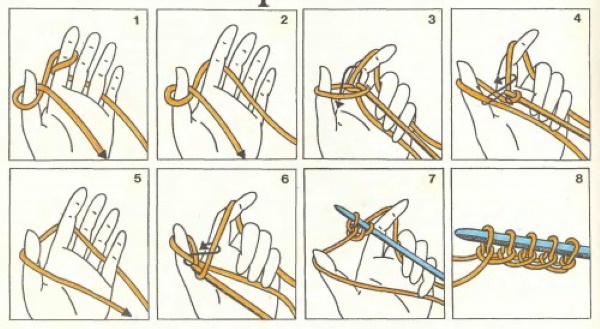
The Italian technique allows you to form a neat and elastic edge without rounded outlines. It is created using the 1 x 1 pattern or a double elastic band. The first 4 rows of loops are cast on with knitting needles a full size smaller than the main fabric of the cuffs or the bottom bar.
Set of loops for elastic band 1 x 1
This pattern is used when knitting:
- sweaters;
- cardigan;
- warm socks;
- mittens;
- hats;
- snood scarf.
For a 1 x 1 elastic band, the number of loops is a multiple of two.
To work you will need:
- thin metal spokes;
- crochet hook;
- wool yarn;
- additional elastic thread.
The set diagram is shown in the table below:
| Row | The principle of recruitment |
| 1st | The front loop is passed behind the back wall, and the back loop is removed. The thread is tightened in front of the previous loop. |
| 2nd | The front loop is knitted through the front wall, and the next loop is removed. |
| 3rd | Completely repeats the previous one. |
| 4th | Similar to the strip standing above it. |

Italian elastic knitting, pattern 1 x 1, involves creating the 5th row with a tool one unit thicker than the four previous ones. The front loop is threaded through the front wall. This method is called classic.
Alternative knitting method:
- crochet a chain of air loops using elastic thread;
- first forms half of the required number of loops;
- the fabric is turned over and the front elements are picked up through the loops using the main thread;
- The 3rd, 4th and 5th rows are knitted in stocking stitch.
The outer loops of the elastic are transferred to another knitting needle. Then the knitting is folded in half - with the wrong side inside. Now you will need a third knitting needle. With it, loops are knitted alternately from both edges.
On one needle they are knit stitches, on the other they are purl stitches. The required number of rows are knitted in this way. The edge of the garment formed using this technique is dense and elastic. It does not stretch even when the garment is worn for a long time.
For elastic 2 x 2
The set begins similarly to the single version, adding rows with several manipulations. The work is performed with tools that are used to set the entire canvas.
Sequence of actions:
- The main yarn is held with the index finger.
- The 1st loop is formed on one knitting needle.
- The end of the thread is fixed with the thumb of the other hand.
- The spoke is placed in the middle.
- The instrument is inserted under the thread held by the thumb.
- Using the same knitting needle, grab another thread.
- The working tool is pulled towards you. As a result of these actions, an unusual facial loop will be formed.
- The needle is pulled down and passed under another thread.
- The first thread is caught and pulled tight. As a result, a special type of purl loop is formed.
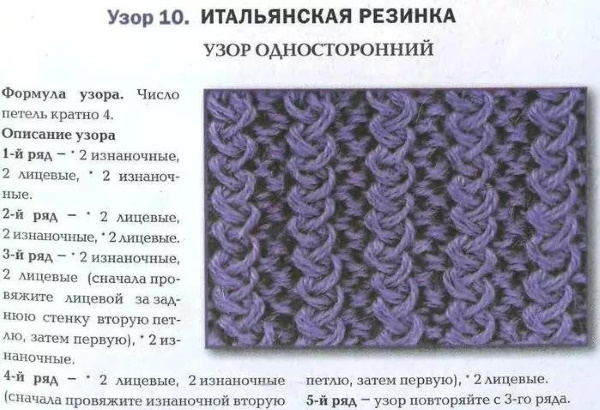
These manipulations are repeated until the required number of loops are created. Italian elastic knitting pattern 2 x 2, provides for a set of such a number of elements that is divisible by 4 without a remainder.
Italian set in a circle
This method allows you to give the edge of a knitted product high elasticity, which is not lost during long-term use of the item. This technique is often used when knitting winter hats. To firmly fix the edging, a bobbin elastic is used as an auxiliary thread. Its ends are securely fastened. This is what gives the product the required degree of elasticity.
The procedure is as follows:
- The 1st chain, cast on using the classic method, is distributed over four needles of the same size;
- The outer loops are connected with an additional element;
- the fabric is unfolded so that the bottom strip begins with the last loop of the row above;
- the thread is placed in front of the front loop;
- The back piece is removed and transferred to another knitting needle.
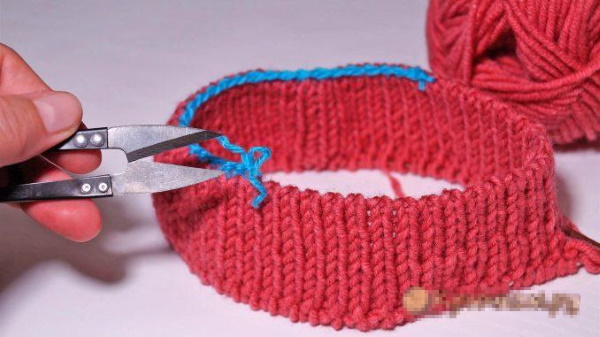
When creating the 2nd chain, the manipulations are performed exactly the opposite. The purl loops are formed in the classic way, and the front loops are removed. The entire fabric is created by alternation.
Italian Elastic Edge Loop Cast On
This technique is used when knitting cuffs, necklines, the bottom edge of pullovers and other winter items. It allows the garments to retain their given geometric shape for a long time and makes them practical for everyday use.
Italian elastic knitting pattern with elastic edge, knitted with two tools of the same size. Requires the main wool yarn and additional stretchy thread.
Sequence of actions:
- using an additional elastic thread, cast on half of the planned number of loops;
- during further work this thread is not delicate, so it can be cut;
- subsequent actions are performed with the main yarn;
- The 1st chain of loops is knitted with the front stitch, the edge pieces are not removed;
- 2nd row – all purl;
- 3rd – facial again;

Before creating the 4th row, the fabric is turned over, the edge loop is removed, and a purl is formed. The loop from the first row is pulled up, put on the working knitting needle and knitted with the front version. Then comes the purl loop, which is already strung on the tool. Further work is performed in alternation - the purl elements are knitted from similar loops of the previous row, and the front ones from the broaches.
For ease of lifting the loops, use a hook or an additional knitting needle. At the end of the 4th row, the number of loops will reach the required amount. You can begin to form the 5th strip. It is knitted sequentially, copying the pattern of the previous row. After finishing the work, the additional thread is unraveled and pulled out of the fabric.
Italian Circular Cast on
This technique is used when knitting sleeve cuffs of warm woolen clothes, the bottom edge and neck of pullovers. The circular pattern of Italian elastic with knitting needles of the same size is called tubular or tubular.
Work with straight wooden tools, as they are easier to cast on. Metal knitting needles on a fishing line will do. Cast on an even number of loops.
The front elements alternate with the back ones throughout the strip. The last loop secures the previous ones. It is necessary to ensure that the fabric remains even and does not twist. With circular knitting needles, form the 1st row of hollow elastic.
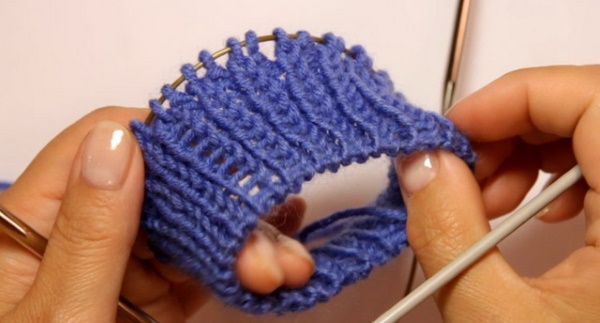
Knitting is closed in a ring. Starting from the second chain of loops, the creation of an elastic insert is performed in a circle. The 3rd row completely duplicates the 1st. Having completed 5 stripes, you can move on to a simple 1 x 1 pattern.
Italian elastic knitting - a classic method!
This knitting technique allows you to create unique and individual items. They are stylish, comfortable, durable and practical. The Italian method is called classic. It is easy to learn and implement.
Necessary materials
To knit using the Italian method and to complete the patterns related to it, you will need:
- woolen threads of medium thickness;
- straight knitting needles numbers 3-5;
- elastic yarn in a contrasting color;
- crochet hook.
To create voluminous cuffs and a bottom bar with a three-dimensional pattern, use 4 metal knitting needles on a fishing line or thin cable.
Sequence of work step by step
The order and method of knitting are determined by the chosen pattern for forming loops.
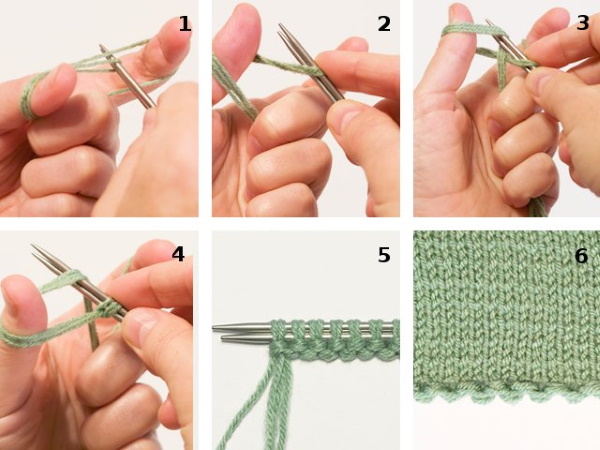
When creating a classic Italian elastic band, the sequence of work is as follows:
- the number of stitches cast on must always be a multiple of 4;
- at the beginning of the process, 20 loops are cast on in the standard way, taking into account the edge loops;
- then knit a purl chain;
- The lower strip is formed by alternating two edge loops with two purl loops.
- finish the first strip with an edge piece;
- The 2nd strip is formed from the front elements;
- The 3rd row begins with an edge loop, then 2 front loops and 2 back loops;
- 4th and 5th lanes – similar to the third.
This elastic band looks interesting. It plays not only a functional role, but also a decorative and aesthetic one.
An improved version of the Italian elastic - choose the edge!
The classic method allows you to create a specific configuration of the lower edge, which is not appropriate for all knitted products. Therefore, an improved version of this knitting technique is often used. In it, the pattern begins immediately after the cast-on row.
Necessary materials
You will need wool yarn for the base and a contrasting elastic thread. For work, use metal or wooden knitting needles of medium length. The tools can be on a fishing line or a thin cable.
Sequence of work step by step
With this technique, odd stripes are knitted with the purl method, and even stripes are knitted with the front method.

The order of operations:
- The first chain is an alternation of purl and knit stitches. It begins and ends with an edge element.
- The created fabric is turned over. An edge loop and two front loops are formed - the last one is passed behind the back wall, the first one - behind the front wall. They are not removed from the knitting needle. Then two back loops are formed. The operations are repeated until the second chain is completed.
- The 3rd strip begins with a loop of the edge type. Consecutively form two elements of the purl variety. The manipulation is repeated until the chain is complete.
- The 4th row copies the pattern of the second strip.
With this technique of creating Italian elastic, the edge looks perfectly even and beautifully decorated.
From straight knitting to bulky knitting - new technique!
Various fashionable winter clothing items are knitted in this way:
- hats;
- snoods;
- oversize sweaters;
- gaiters;
- cardigans;
- pullovers.
This technique allows you to create a cozy collar, decorative cuffs, an interesting looking bottom bar. Using circular knitting needles is slightly different from the method, which involves using a straight knitting tool.
Necessary materials
Not very long metal double-pointed knitting needles on a fishing line or cable will do. You can choose a stocking knitting tool. Use wool yarn of the selected shade and elastic thread of a contrasting color to form an expressive volumetric ornament.
Sequence of work step by step
Using the classic Italian method or an improved version of it, cast on the required number of loops, adding an additional one.
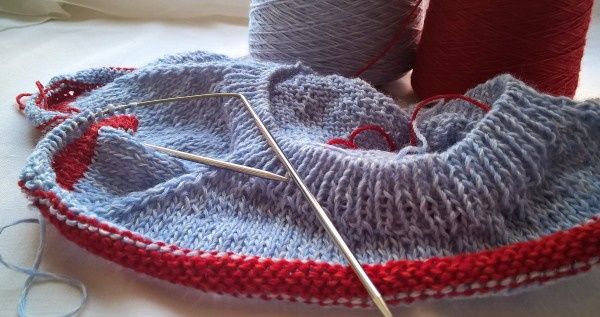
The further course of work is as follows:
- If a stocking pattern tool is chosen for knitting, the formed loops are evenly distributed on it.
- The canvas is closed into a circle using the initially created auxiliary element.
- The first loop, which has not yet been knitted, is pulled through the removed loop. This method will allow you to accurately dial the planned number of loops.
- The fabric is turned over so that the last knitted element is the first.
- The circular strip is formed by an even combination of purl and knit stitches. The thread is held in front of the working tool.
- When creating the next strip, the front loops are transferred to another knitting needle - not tightened, but carefully removed. The elements of the back variety are attached to similar loops of the chain above.
After finishing the 5th strip, work continues in the classical way, knitting a fabric of the required size.
Italian method of casting on stitches with an additional thread
It is important to correctly place the additional thread before starting work. It is guided with the index finger, holding it with the others. The thumb remains free. The auxiliary thread should be two to three times longer than the total length of the fabric.
Necessary tools
To create an elastic insert with an additional thread, use metal knitting needles and a crochet hook. You will need wool and elastic threads. To close the loops, you should prepare a sewing needle in advance.
Sequence of work step by step
It is advisable to use an elastic thread 25 cm long for every 10 cm of fabric. The first loop is of the edge variety. It is cast on using the classic Italian method.
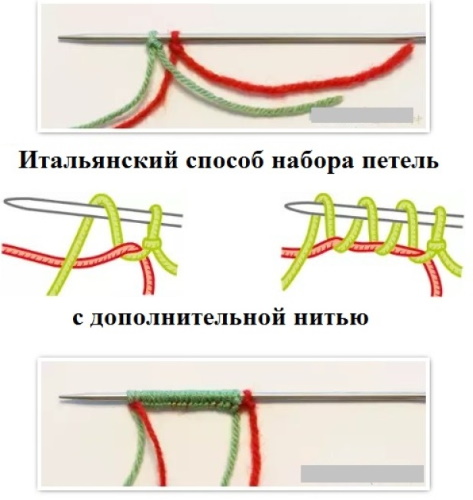
The sequence of further actions:
- The little finger fixes the main and auxiliary threads. To make the work easier, you can use a crochet hook.
- An additional thread is thrown onto the knitting needle, simultaneously pulling a loop out from under it.
- Place the main thread on top. Insert the needle under the additional thread and pull out another loop.
- Remove the edge element from the knitting needle.
- The front loops are knitted with the main thread.
- The purl stitch is removed from the working needle.
- They transfer it to another instrument.
- Before completing the chain, the front loops are knitted, and the back loops are removed.
The fabric is formed to the required length according to the 1 x 1 pattern. The result is a stylish element of a clothing detail with an interesting pattern. It will become an original fragment of the overall ornament of a wardrobe item. The pattern of Italian elastic knitting with an additional thread looks beautiful both from thick yarn and from thin. It tightens the clothing detail well and gives elasticity to any thing.
Author: Shepherd Pavel Vitalievich (pavel06)
Video about knitting Italian elastic
Italian elastic 1x1 in a circle:
